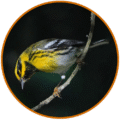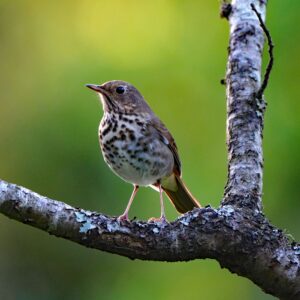
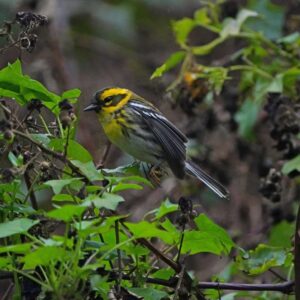
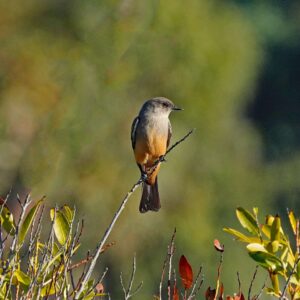
As I write this, I’m far from the “shadow of the bridge,” sitting on the opposite side of the country as San Francisco Bay. Windows open, I can hear the Atlantic lapping at the shore of Brighton Beach, and a lone Osprey is riding the wind among a flock of urban paragliders. But tonight—a colorful BirdCast map tells me—the very same phenomenon will occur in the sky above me as will be occurring thousands of miles away above my home in Berkeley.
On October nights across the Bay Area—and across much of North America—while most of us sleep, millions of birds are passing overhead in the darkness. Warblers, thrushes, and sparrows navigate by starlight, traveling thousands of miles between their breeding and wintering grounds. For centuries, this nocturnal journey remained one of ornithology’s greatest mysteries—until technology finally gave us a window into the night sky.
If you stand on the Marin Headlands on a clear fall night and look up, you might see nothing but stars—yet the air around you is alive with movement. The phenomenon of bird migration puzzled naturalists for generations. Aristotle famously believed that swallows hibernated in mud during winter. It wasn’t until the 19th century that scientists confirmed birds actually migrated, but the scale and timing of these movements remained unclear. The breakthrough came from an unexpected source: weather radar. During World War II, radar operators noticed mysterious “angels” in the night—phantom echoes that appeared on their screens. These weren’t enemy aircraft but massive flocks of migrating birds.
Today, the BirdCast project uses NEXRAD radar data (the same technology used by the National Weather Service!) to track bird migrations in real-time across North America. You can check county-by-county forecasts for the Bay Area, watching as waves of migrants pass through San Francisco, Alameda, Santa Clara, and Marin counties. The radar reveals not just that birds are migrating, but when peak movements occur and how many birds are aloft—sometimes hundreds of thousands in a single night!
But radar only tells part of the story. The birds themselves have another secret: they sound completely different at night than they do during the day. Instead of the familiar songs we hear in our gardens, nocturnal migrants emit short, sharp flight calls—chips, zees, and tseets that help them maintain contact with others in their flock and navigate through darkness. Step outside after dark and train your ears, and you might catch it: the sound of strange, sharp bird calls filling the night air.
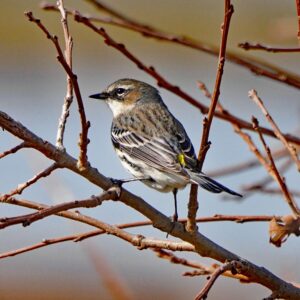
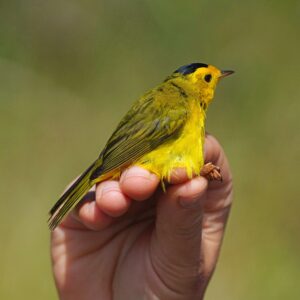
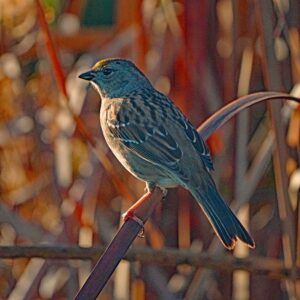
For years, these calls went largely unrecognized. Pioneering researchers like Bill Evans (no relation to our photographer, Dick Evans) spent decades in the 1990s and 2000s recording and cataloging these sounds, creating the first comprehensive libraries of nocturnal flight calls. The work was painstaking—imagine distinguishing between species based on calls lasting mere fractions of a second! Because of this hard work, now the website Nocturnal Flight Calls of North America offers recordings and spectrograms that allow anyone to learn these distinctive voices of the night. If you’re a local Bay Area birder comfortable with identifying birds by sound during the day, consider this your next challenge: learning the calls of your favorite migrants in the night.
And who should we be listening for right now? Walk through Golden Gate Park on an October morning and you’ll notice the changes: a flash of yellow in the Monterey pines that wasn’t there yesterday, an unfamiliar bird foraging in the eucalyptus litter. Early October marks prime migration season in the Bay Area. Swainson’s and Hermit Thrushes are moving through in large numbers, their liquid calls drifting down. Yellow-rumped Warblers and tiny Ruby-crowned Kinglets are arriving, along with Golden-crowned and White-crowned Sparrows.
The best places to witness evidence of this migration are parks and green spaces near the coast. The Presidio, Golden Gate Park, Point Reyes National Seashore, and the East Bay Regional Parks serve as critical stopover habitat where exhausted migrants rest and refuel along the Pacific Flyway. Riparian corridors along creeks—like Alameda Creek or San Francisquito Creek—act as highways for traveling birds. Even small urban parks can host remarkable numbers of migrants during peak movement. At Point Reyes, Point Blue Conservation Science has been studying bird migration since 1965, operating the longest-running bird population study west of the Mississippi River. Their Palomarin Field Station welcomes visitors to observe bird banding demonstrations—a chance to see these nighttime travelers up close in daylight.
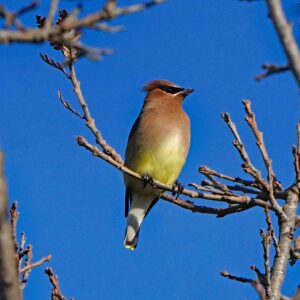
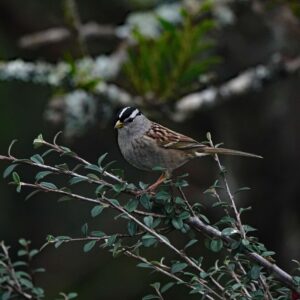
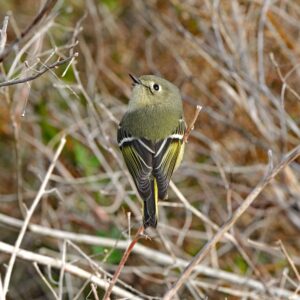
While BirdCast shows us real-time snapshots of migration, Point Blue’s decades of banding data reveal something deeper: how migration itself is changing. Their capture rates track which species pass through and when, documenting shifts in arrival times as spring warms earlier and fall lingers longer. The data also captures how birds are responding to habitat transformations at Palomarin—the gradual march of Douglas-fir forests replacing coastal scrub, the effects of drought and fire. These patterns, influenced by our changing climate, are reshaping migration timing and the composition of species moving through the Bay Area. Curious observers can explore these long-term trends themselves through Point Blue’s interactive data portal, where decades of careful science become visible in charts tracking the pulse of migration across seasons and years.
As Bay Area citizens, we all play a role in the lives of migratory birds. Imagine a Golden-crowned Sparrow, having traveled by night for weeks on its way south from Alaska, finally spotting the green refuge of the Presidio, only to be drawn fatally off course by the glow of downtown windows. Light pollution disorients night-migrating birds, causing them to collide with buildings. Turning off unnecessary lights—especially on nights when BirdCast forecasts peak migration numbers—can save thousands of lives. The Audubon Lights Out program seeks to make a difference—San Francisco has signed on, and perhaps you also live in a city that wishes to participate!
Keeping cats indoors is crucial, too. And planting native species in your yard provides the insects and berries that fuel these epic journeys!
Above all, paying attention is perhaps the most important way of all to stay curious about birds, and to cultivate care. Next time you’re outside on an October evening, pause and listen. Those sharp calls in the darkness above are the sounds of one of nature’s greatest spectacles playing out over the Bay Area—and across our entire continent!—under cover of darkness.
